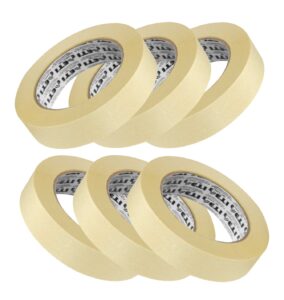A Comprehensive Guide to Masking Tape for Carpenter and Woodwork Application
Masking Tape: A Carpenter’s Essential Tool for Precision and Quality in Woodworking
Masking tape stands as one of the most valuable tools in a carpenter’s kit, especially for intricate woodwork. Its versatility, easy application, and ability to provide clean, defined lines make it an essential material for various tasks. This article explores the importance of carpenter tape in carpentry and woodworking, and how it enhances precision and elevates the quality of projects.
What is Masking Tape?
Masking tape is a type of pressure-sensitive adhesive tape that can be easily torn by hand and removed without leaving residue. While originally designed for painting to protect areas that shouldn’t be painted, carpenters have adopted it for its ability to create clean, defined edges on wood during cutting, staining, or varnishing.
In woodworking, Painter’s tape serves multiple purposes. Carpenters rely on it to assist with glue-ups, protect surfaces from sawdust or stains, and ensure a professional finish, especially when working on fine details.
Key Uses of Masking Tape in Carpentry
1. Surface Protection
Carpenters use masking tape to shield delicate wood surfaces during tasks like sanding, painting, or staining. This becomes especially important when working with multi-textured surfaces. For instance, if you’re staining a table with both wood and metal elements, you can apply masking tape to the metal parts to protect them from stains and sanding debris.
2. Creating Clean, Straight Edges
carpenter tape plays a vital role in creating straight, crisp edges when cutting plywood, timber, or laminated surfaces. It prevents chipping at the edges and provides a smooth finish. When making precise cuts or trimming veneers, carpenters often place tape along the cutting line to hold wood fibers in place, minimizing the risk of splintering or rough edges.
This technique proves especially useful when working on cabinets or shelving units. By applying pressure before cutting, This tape ensures the edges remain sharp and clean.
3. Assisting in Glue-Ups
Precise joints are crucial for both durability and aesthetics in woodworking. This tape comes in handy during glue-ups, particularly with intricate joints like dovetails or box joints. It acts as a temporary clamp to hold pieces together and prevent glue from spilling onto the wood’s surface. This method keeps your workspace clean and ensures glue only adheres to where it’s needed.
4. Marking and Measuring
Masking tape also provides a non-intrusive way to mark specific areas for cutting or drilling. Whether you’re working on a custom furniture piece or a decorative wood panel, masking tape allows you to make clear measurements and guides without leaving any permanent marks on the wood. After finishing the task, simply remove the tape, and the wood remains clean.
5. Holding Templates in Place
When working on detailed projects or mass production designs, templates are common. Masking tape is perfect for securing these templates without causing any damage to the wood. Whether you’re using a circular saw guide or a routing template, masking tape offers reliable adhesion that holds firmly, yet allows for easy adjustments.
Benefits of Masking Tape in Woodworking
1. Leaves No Residue
One of the biggest concerns for woodworkers is whether tape will leave behind sticky residue, potentially ruining the surface. Quality masking tape ensures clean removal without leaving any marks, keeping your wood surfaces pristine.
2. Versatile Across Projects
From delicate decorative tasks to heavy-duty carpentry,This tape proves its versatility. It works well on various wood types, laminated surfaces, and even painted wood, making it suitable for a broad range of carpentry and furniture-making projects.
3. Easy to Use
Its pressure-sensitive adhesive allows for quick and easy application and removal. You can tear it by hand, apply it directly to wood, and remove it without the need for additional tools. Thus makes this tape ideal for quick adjustments or protecting surfaces during large projects.
4. Cost-Effective
Masking tape offers a great cost-to-benefit ratio, making it an attractive option for both hobbyists and professional carpenters. Despite being affordable, it helps achieve professional-level results in woodworking projects.
Choosing the Right Masking Tape for Woodworking
When selecting masking tape for your woodworking projects, it’s essential to consider a few factors:
1. Adhesive Strength
Different projects call for different levels of adhesive strength. For delicate wood surfaces, choose a lighter adhesive to ensure the tape can be removed without damaging the wood. For tasks requiring strong adhesion, such as securing heavy templates, a tape with stronger adhesive may be necessary.
2. Tape Width
Masking tapes come in various widths. Narrow tape works well for detailed tasks, while wider tape is ideal for covering larger areas. Carpenters should consider the size of the surface they need to protect when selecting the width.
3. Heat and Moisture Resistance
Some projects may expose the wood to heat or moisture, particularly when finishing wood with varnishes or adhesives. Heat-resistant and moisture-resistant tapes will ensure that the tape maintains its adhesion throughout the process without warping or shrinking.
Common Types of Masking Tape for Carpentry
1. Standard Masking Tape
This tape serves as a go-to for general-purpose tasks like surface protection, marking, and light-duty applications. Carpenters often use standard tape for simple tasks that don’t require high levels of precision or strength.
2. Painter’s Tape
Painter’s tape offers a higher level of precision, making it ideal for detailed woodwork where clean lines are critical. It’s also less likely to leave residue behind, which is particularly important when working with stained or varnished surfaces.
3. High-Adhesive Masking Tape
When a task requires extra hold, such as securing heavy templates, high-adhesive tape becomes the best choice. However, be cautious when using it on delicate surfaces, as the strong adhesive may damage the wood when removed.
Masking Tape: A Critical Tool in Every Woodworker’s Kit
It remains an indispensable tool in carpentry and woodworking, providing numerous applications such as surface protection, precise cutting, assisting with glue-ups, and marking measurements. Its versatility, ease of use, and affordability make it an essential tool for achieving professional results in any project. Whether working on large furniture pieces or smaller, more intricate tasks, masking tape ensures a clean, polished finish and enhances the quality of your craftsmanship.

